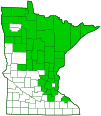American black bear
(Ursus americanus)
Conservation • Description • Habitat • Ecology • Distribution • Taxonomy
Conservation Status |
|||
| IUCN Red List | LC - Least Concern |
||
| NatureServe | N5 - Secure SNR - Unranked |
||
| Minnesota | not listed |
||
Description
American black bear is a large, common though rarely seen, solitary, omnivorous mammal. It is usually
In Minnesota the black bear is usually black with a pale brown muzzle and usually a small white chest spot. About six percent of the bears in Minnesota are “non-black” color morphs (Rounds, 1987). These can be brown, cinnamon, or yellowish brown, and can occur within populations and even within litters.
Size
Head and body: 5′ to 6′
Sign
Similar Species
No similar species
Habitat
Forests, swamps, wooded areas.
Ecology
Behavior
Lifespan
18 to 23 years or more
Life Cycle
Male territories overlap those of several females. Breeding takes place in June and July. Females give birth usually every 2 years, sometimes waiting 3 or 4 years. The gestation period is about 220 days.
A litter of 1 to 5, usually 2 or 3, cubs ar born in January or February when the female is in hibernation. The cubs remain with their mother about 17 months, sharing her den in their second winter.
Lifespan in the wild can be up to 30 years, but average lifespan is 10 years due to interaction with humans, including hunting.
Food
Inner tree bark, grasses, and forbs in the spring; nuts, roots, berries, grasses, buds, colonial insects, beetles, small mammals, carrion, fish, and garbage in summer and fall; nothing in the winter.
Distribution |
||
|
Sources Biodiversity occurrence data published by: Minnesota Biodiversity Atlas (accessed through the Minnesota Biodiversity Atlas Portal, bellatlas.umn.edu, 12/7/2025). Timm, R. M. 1975. Distribution, natural history, and parasites of mammals of Cook County, Minnesota. Occasional Papers, Bell Museum of Natural History, University of Minnesota 14:1–56. Hazard, Evan B. 1982. The Mammals of Minnesota. University of Minnesota Press, Minneapolis, Minnesota. 280 pp. |
|
| 12/7/2025 | ||
Occurrence |
||
Locally common There are about 20,000 American black bears in the state. |
||
Taxonomy
Class
Subclass
Theria
Infraclass
Placentalia (Placental Mammals)
Magnorder
Boreoeutheria
Superorder
Laurasiatheria (Ungulates, Carnivorans, and Allies)
Order
Carnivora (Carnivorans)
Suborder
Caniformia (Dog-like Carnivores)
Infraorder
Arctoidea
Parvorder
Ursida
Family
Ursidae (Bears)
Subfamily
Ursinae (Typical Bears)
Genus
Ursus (Holarctic Bears)
Subgenus
Euarctos
Subordinate Taxa
California black bear (Ursus americanus californiensis)
cinnamon bear (Ursus americanus cinnamomum)
Dall black bear (Ursus americanus pugnax)
east Mexican black bear (Ursus americanus eremicus)
eastern black bear (Ursus americanus americanus) ![]()
Florida black bear (Ursus americanus floridanus) *
glacier bear (Ursus americanus emmonsii)
Haida Gwaii black bear (Ursus americanus carlottae)
Kenai black bear (Ursus americanus perniger)
Kermode bear (Ursus americanus kermodei)
Louisiana black bear (Ursus americanus luteolus) *
New Foundland bear (Ursus americanus hamiltoni)
New Mexico black bear (Ursus americanus amblyceps)
Olympic black bear (Ursus americanus altifrontalis)
Vancouver black bear (Ursus americanus vancouveri)
west Mexico black bear (Ursus americanus machetes)
* Subspecies validity
A recent phylogeographic analyses of American black bears (Puckett et al., 2015) does not support the designation of the subspecies U. a. floridanus and U. a. luteolus, and suggests that they should be grouped with U. a. americanus.
Synonyms
Euarctos americanus
Euarctos vitabilis
Ursus amplidens
Ursus optimus
Common Names
American black bear
eastern black bear
Visitor Photos
Share your photo of this mammal.
This button not working for you?
Simply email us at info@MinnesotaSeasons.com.
Attach one or more photos and, if you like, a caption.
Luciearl |
 |
This is from two years ago in June. Mama bear's triplets were sleeping in the big red pine near our deck. She laid on our stairs waiting for them to wake up. |
Dan W. Andree |
 |
Black Bear Spotted... Bears have been spotted in my area over the past few years or so, but this was my first encounter with one. I was coming down a hill at Frenchman’s Bluff SNA when I noticed it. It wasn’t aggressive just curious. It just stared at me panting due to the heat and humidity that day so I filmed it and made this image from a frame grab. It eventually just took off into some woods at the edge of the prairie and disappeared. Felt fortunate to see one in a nice setting too. |
Bobbi Johnson |
||
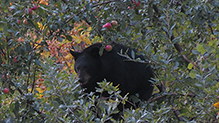 |
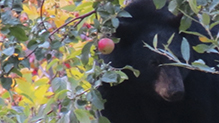 |
|
Ramona Abrego |
||
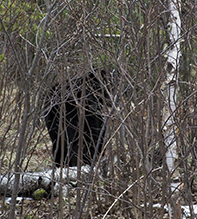 |
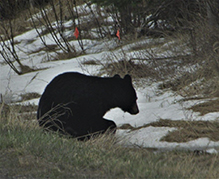 |
|
Wild bear on Gunflint Trail … |
||
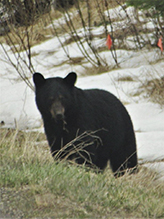 |
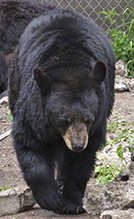 |
|
Wild bear on Gunflint Trail … |
… and one captive bear at Wildlife Science Center | |
Christa Rittberg |
||
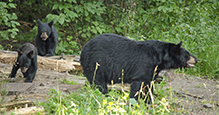 |
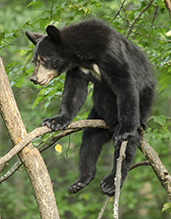 |
|
MinnesotaSeasons.com Photos
Brown color morph — Captive bear at North American Bear Center |
||
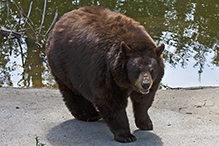 |
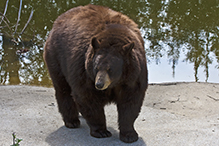 |
|
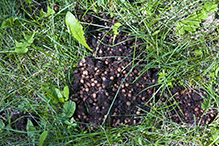 |
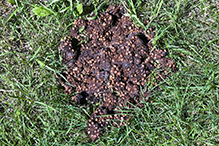 |
|
Sign |
Sign | |

Slideshows
Black Bear
Andree Reno Sanborn
Ursus americanus (American Black Bear)
Allen Chartier
Black Bears
Ashley Hockenberry
Black Bears
Larry W. Brown

Visitor Videos
Share your video of this mammal.
This button not working for you?
Simply email us at info@MinnesotaSeasons.com.
Attach a video, a YouTube link, or a cloud storage link.
Other Videos
North American Black Bear - Ursus americanus - YouTube
JCVdude
Black Bears at the American Bear Association - Orr, Minnesota
TheAmericanBear

Visitor Sightings
Report a sighting of this mammal.
This button not working for you?
Simply email us at info@MinnesotaSeasons.com.
Be sure to include a location.
Dan W. Andree
7/13/2024

Location: Frenchman’s Bluff SNA
Bears have been spotted in my area over the past few years or so, but this was my first encounter with one. I was coming down a hill at Frenchman’s Bluff SNA when I noticed it. It wasn’t aggressive just curious. It just stared at me panting due to the heat and humidity that day so I filmed it and made this image from a frame grab. It eventually just took off into some woods at the edge of the prairie and disappeared. Felt fortunate to see one in a nice setting too.
Findley
4/15/2023
Location: Zumbrota
looked dark brown. It looked like it was a „larger“ cub sitting by electrical box between my house. I went to get my mail & just stared at me. Then saw it run across street into a small wooded area.
Wish I had a camera with me!
It was NOT a dog, possum, raccoon-a bear cub
MinnesotaSeasons.com Sightings

